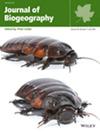Phylogenetic Diversity of Live-Bearing Fishes (Poeciliidae) Peaks on Peninsulas, Isthmuses, and in Deserts
Abstract
Aim
Poeciliids are ecologically important, are widely used as pets, and also have value as model organisms. To understand diversity within this family, we study their phylogenetic diversity (PD) at regional and local scales to delimit bioregions and identify patterns of biodiversity.
Location
The Americas.
Taxon
Poeciliidae (Actinopterygii: Cyprinodontiformes).
Methods
We expanded an existing dated phylogeny from 164 to 261 species with distributional data for 1o × 1o latitude × longitude cells (~111 km2) and conducted a cluster analysis (phylo-jaccard distance) to delineate bioregions. For individual cells, we mapped species richness (SR), phylogenetic diversity (PD), weighted endemism (WE) and phylogenetic endemism (PE). We used randomisation tests to map phylogenetic clustering and over-representation of short-branch species by cell. We used categorical analysis of neo- and palaeo-endemism to map neo-, palaeo-, mixed and super (mixed) endemism.
Results
We delineated six bioregions. Highest regional species density and density of PD occurred on the Isthmus of Panamá (IOP). At the grid-cell scale, the Grijalva–Usumacinta drainage is a hotspot for SR, PD, PE and WE; the IOP has high PD and PE; the Isthmus of Tehuantepec (IOT) has high PD, WE and moderately high SR; and western Hispaniola has high WE and moderately high SR. The Grijalva–Usumacinta drainage also includes cells of super (mixed) and palaeoendemism, while mixed endemism is widespread in Middle America and the Greater Antilles. Phylogenetic clustering is widespread, whereas over-representation of short-branch species is concentrated in the Chihuahuan Desert–Sierra Madre Oriental region and in western Hispaniola, both hotspots of neoendemism.
Main Conclusions
We found widespread diversification of genera intermixed with relict species (mixed endemism). Furthermore, SR and PD were strongly correlated. Centres of endemism include the Chihuahuan Desert–Sierra Madre Oriental, western Hispaniola, the IOT, the IOP and (most of all) the Grijalva–Usumacinta drainage. However, conservation efforts must occur within each bioregion and for each genus.

 求助内容:
求助内容: 应助结果提醒方式:
应助结果提醒方式:


